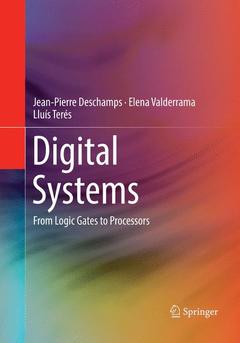Description
Digital Systems, Softcover reprint of the original 1st ed. 2017
From Logic Gates to Processors
Language: English
Subjects for Digital Systems:
Publication date: 06-2018
Support: Print on demand
Publication date: 10-2016
Support: Print on demand
Description
/li>Contents
/li>Biography
/li>Comment
/li>
This textbook for a one-semester course in Digital Systems Design describes the basic methods used to develop ?traditional? Digital Systems, based on the use of logic gates and flip flops, as well as more advanced techniques that enable the design of very large circuits, based on Hardware Description Languages and Synthesis tools. It was originally designed to accompany a MOOC (Massive Open Online Course) created at the Autonomous University of Barcelona (UAB), currently available on the Coursera platform.
Readers will learn what a digital system is and how it can be developed, preparing them for steps toward other technical disciplines, such as Computer Architecture, Robotics, Bionics, Avionics and others. In particular, students will learn to design digital systems of medium complexity, describe digital systems using high level hardware description languages, and understand the operation of computers at their most basic level. All conceptsintroduced are reinforced by plentiful illustrations, examples, exercises, and applications. For example, as an applied example of the design techniques presented, the authors demonstrate the synthesis of a simple processor, leaving the student in a position to enter the world of Computer Architecture and Embedded Systems.
Digital Systems.- Combinational circuits.- Arithmetic blocks.- Sequential circuits.- Synthesis of a processor.- Design methods.- Physical implementation.-
Jean-Pierre Deschamps received his MS degree in electrical engineering from the University of Louvain, Belgium, in 1967, his PhD in computer science from the Autonomous University of Barcelona, Spain, in 1983, and his second PhD degree in electrical engineering from the Polytechnic School of Lausanne, Switzerland, in 1984. He has worked in several companies, among others Philips, and universities, in Belgium, Spain and Argentina. He is currently a professor at the University Rovira i Virgili, Tarragona, Spain. His research interests include ASIC and FPGA design, digital arithmetic and cryptography. He is the author of nine books and of more than a hundred international papers.
Elena Valderrama has a PhD in Physics Science and a Degree in Medicine from the Autonoma University of Barcelona (UAB), Spain. She is currently Professor at the Microelectronics department in the Engineering School of the UAB. From 1980 to 1998 she was an Adscript Researcher of the National Centre for Microelectronics, and Institute of the Spanish Superior Board for Scientific Research (CSIC), where she lead several projects in which the design and integration of highly complex digital systems (VLSI) was crucial. Her current interests focus primarily on Education, not only from the side of the professor but also on the management and quality control in Engineering related educational programs. Her research moves around the biomedical applications of Microelectronics.
Lluis Terés received Engineering (1981) and PhD (1986) degrees in Computer Sciences from the Autonoma University of Barcelona (UAB). He is with the National Centre for Microelectronics (CSIC), Barcelona Institute, since its creation in 1985. He is head of Integrated Circuits & Systems (ICAS) group, with research activities ranging from hardware description languages, flexible platform based design, up-to low power analogue-digital-mixed CMOS circuits design, N/MEMS sen




